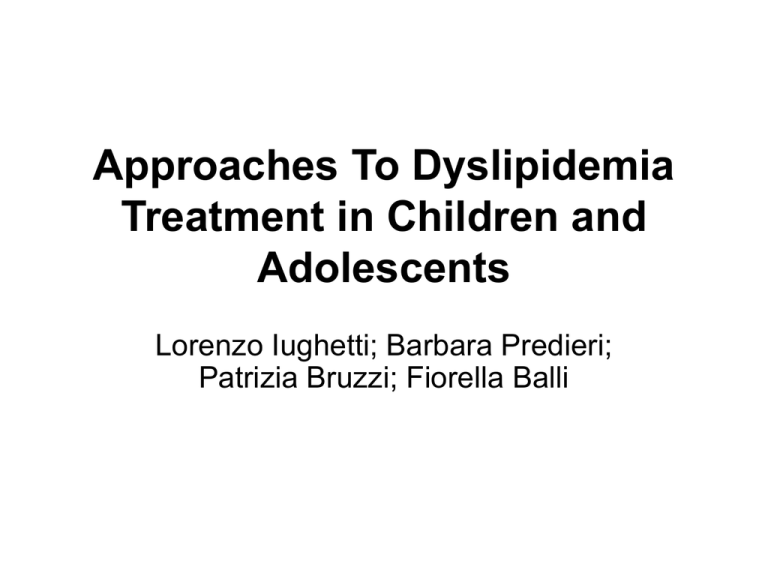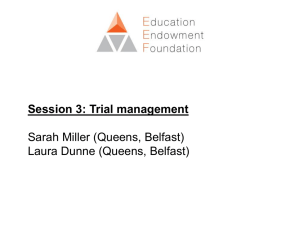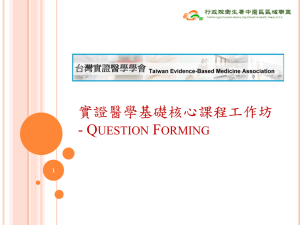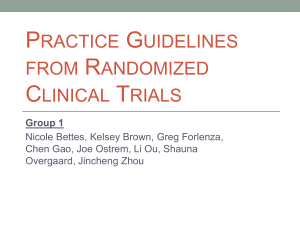Approaches To Dyslipidemia Treatment in Children and Adolescents
advertisement

Approaches To Dyslipidemia Treatment in Children and Adolescents Lorenzo Iughetti; Barbara Predieri; Patrizia Bruzzi; Fiorella Balli Table 1. Major Genetic Disorders of Lipid Metabolism Genetic primary disorder Genetic defect Clinical features FH LDL-R, dimished LDL-C clearance Heterozygotes: xanthomas on the extensor tendons of the hands and feet, arcus corneae and premature CVD; TC: 250-500 mg/dL (LDL-C>135 mg/dL) Homozygotes: xanthomas and very premature CVD; TC: 500-1000 mg/dL Other autosomal dominant hypercholesterolemia PCSK9, diminished LDL-C clearance Heterozygotes: xanthomas on the extensor tendons of the hands and feet, arcus corneae and premature CVD; TC: 250-500 mg/dl (LDL-C>135 mg/dl) Homozygotes: xanthomas and very premature CVD; TC:500-1000mg/dl ARH ARH adaptor protein absent or unable to interact with the LDL-R, diminished LDL-C clearance Variable, phenotype similar to homozygous FH, but generally less severe and more responsive to lipid-lowering therapy; large and bulky xanthomas from early childhood; TC>500 mg/dl Familial defective ApoB-100 ApoB-100, diminished LDL-C clearance Xanthomas, arcus senilis and premature CVD; TC: 250-500 mg/dl Polygenic hypercholesterolemia Unknown, multiple defects and mechanisms Premature CVD; TC: 250-350 mg/dl Familial hyperchylomicronemia Unknown, possible multiple defects and mechanism TG: 500-1000 mg/dl (occasionally >1000 mg/dl with dietary factors and alcohol); TC high, LDL-C and HDL-C low; frequent episodes of abdominal pain with or without recurrent attacks of acute pancreatites, hepatosplenomegaly, lipemia retinals and eruptive xanthomas; variable Apo-CII deficiency Apo-CII (causing functional complete or partial LPL deficiency) Pancreatites, often associated with metabolic syndrome; hepatosplenomegaly; TG>750 mg/dl; chylomicrons markedly elevated, LDL-C and HDL-C low Familial combined hyperlipidemia Unknown Premature CVD, ApoB elevated; TC: 250-500 mg/dl; TG: 250-750mg/dl Dysbetalipoproteinemia ApoE, impaired chylomicron and VLDL-C clearance Tuberous and tuberoeruptive xanthomas; premature CVD or peripheral vascular disease; abnormal glucose tolerance; TC: 250-500 mg/dl; TG:250-750 mg/dl; VLDL-C markedly increased, LDL-C reduced Hypoalphalipoproteine mia Unknown Variable, premature CVD; HDL-C: 15-35 mg/dl Apo = Apolipoprotein; ARH = Autosomal recessive hypercholesterolemia; C = Cholesterol; CVD = Cardiovascular disease; FH = Familial hypercholesterolemia; HDL = High-density lipoprotein; LDL = Low-density lipoprotein; TC = Total cholesterol; TG = Triglyceride; VLDL = Very-low-density lipoprotein. Table 2. Secondary Disorders of Lipid Metabolism Secondary Disorder Clinical Feature Obesity Increased TG, decreased HDL-C Diabetes mellitus Increased TG and TC, decreasedHDL-C Chronic renal failure Increased TG and TC, decreasedHDL-C HIV/AIDS wasting Increased TG and TC, decreasedHDL-C and LDL-C HIV/AIDS (HAART) Increased TG, TC and HDL-C Hypothyroidism Increased TG, TC and LDL-C Nephrotic syndrome Increased TC and LDL-C Obstructive liver disease Increased TC Medications Variable C = Cholesterol; HAART = Highly-active antiretroviral therapy; HDL = High-density lipoprotein; LDL =Low-density lipoprotein; TC = Total cholesterol; TG = Triglyceride. Table 3. Characteristics and Differences Between STEP 1, STEP 2 and TLC Diets Diet Total fats (% of total calories) Saturated fats (% of total calories) Dietary cholesterol (mg/day) Plants stanols/ster ols (g/day) Increased viscous soluble fiber (g/day) STEP 1 30 No more than 10 Limited to 300 NA NA Step 2 30 Less than 7 Less than 200 NA NA TLC 25-35* Less than 7 Less than 200 2 10-25 *The 25-35% fat recommendation allows for increased intake of unsaturated fat in place of carbohydrates in people with metabolic syndrome or diabetes. NA = Not applicable; TLC = Therapeutic Lifestyle Changes. From National Cholesterol Education Program ATP III Table 4. Studies With Bile Acid-binding Resins in Children With Familial Hypercholesterolemia Drug and dosage (g/day) Author Subjects (n) Age (years) Follow-up Study Mean LDL-C reduction (%) Ref 0.5-0.6 g/kg Mordasini etal. (1978) 20 7-15 16 weeks RCT -25.0 [115] 8-20 g Glueck etal. (1986) 33 5.5-18 5.6 years RCT -12.5 (total cholesterol) [67] 5-30 g Stein (1989) 30 1-20 1-9 years Open -21.0 [116] 0.125-0.25 g/kg Schlierf etal. (1982) 26 3-24 8 weeks RCT -12.0 to -15.0 [117] 10-15 g Groot etal. (1983) 24 7-15 16 weeks RCT -15.7 [118] 10 g Tonstad etal. (1996) 66 10-16 1 year RCT -19.5 [68] 2-12 g Tonstad etal. (1996) 27 10-16 24 weeks Open -20.0 [69] 12-16 g Glueck etal. (1977) 16 9-17 3 years Open -14.0 [119] 4-8 g Wets etal. (1980) 35 1.3-17.4 8 years Open -26.0 to -44.0 (totalcholesterol) [120] 0.36 g/kg Koletzko etal. (1992) 14 2.3-17.8 4-97 months RCT -13.5 [121] 8-24 g Liacouras etal. (1993) 36 6-15 1-2.5 years Open -26.0 [122] 8g Tonstad (1996) 96 6-11 1 year RCT -16.9 to -18.6 [71] 8g McCrindle (1997) 38 10-18 16 weeks RCT -10.0 to -15.0 [70] 8g Hussein (2001) 16 10-18 16 weeks RCT -14.0 [72] Asami (2002) 6 4-16 24 weeks RCT -34.0 [73] Colestipol or cholestyramine Colestipol Cholestyramine Colestilan 4g LDL-C = Low-density lipoprotein cholesterol; RCT = Randomized controlled trial. Table 5. Studies With Statins in Children With Familial Hypercholesterolemia Drug and dosage (mg/day) Author Subjects (n) (M/F) Age (years) Follow-up Study Mean LDL-C reduction (%) Ref. 5-40 Ducobu et al. (1992) 32 (22/10) <17 2-3 years Open -37.3 [78] 20 Couture et al. (1998) 63 (37/26) 8-17 6 weeks RCT -31.0 to -38.0 [123] 10 Stefanutti et al. (1999) 16 (7/9) 4-12 52 weeks RCT -29.0 [79] 10-40 de Jongh et al. (2002) 173 (98/75) 10-17 48 weeks RCT -40.7 [80] 20 Vohl et al. (2002) 47 (28/19) 8-17 6 weeks Open -31.0 to -39.0 [84] 5-20 Dirisamer et al. (2003) 20 (8/12) 10-17 52 weeks Open -25.0 to -36.0 [81] 10 Ferreira et al. (2007) 18 (10/8) 6-18 4 weeks RCT -37 % [83] 5-20 Knipscheer et al. (1996) 72 (25/47) 8.0-16.0 12 weeks RCT -23.3 to -32.9 [85] 10 Hedman et al. (2003) 20 (7/13) 4.9-15.6 8 weeks Open -21.0 [89] 20-40 Wiegman et al. (2004) 214 (100/114) 8.0-18.5 2 years RCT -24.1 [86] 10-60 Hedman et al. (2005) 30 (11/19) 4.1-18.5 2 years Open -24.5 to -32.0 [47] 20-40 Rodenburg et al. (2007) 186 (91/95) 8-18.5 4.5 years RCT - 29.2 [87] 20 Sinzinger (1992) 13 (8/5) 6-13 4 years Open -28.0 to -54.0 [124] 10-40 Lambert et al. (1996) 69 (69/0) 9.3-17.5 8 weeks RCT -21.0 to -36.0 [92] 10-40 Stein et al. (1999) 132 (132/0) 10-17 48 weeks RCT -17.0 to -27.0 [93] 40 Kwiterovich et al.(2001) 132 (132/0) 10-17 3-7 years RCT -27 [94] 20-40 Clauss et al. (2005) 54 (0/54) 10-17 24 weeks RCT -23 to - 27 [95] 10-40 Athyros (2002) 16 (16/0) 10-17 156 weeks Open -45.0 [96] 10-20 McCrindle et al. (2003) 187 (129/58) 10-17 26 weeks RCT -39.6 [97] Van der Graaf (2006) 84 (37/47) 10-16 2 years Open -33.9 [99] Simvastatin Pravastatin Lovastatin Atorvastatin Fluvastatin 80 F = Female; LDL-C = Low-density lipoprotein cholesterol; M = Male; RCT = Randomized controlled trial.







